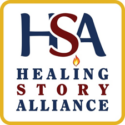by Lewis Mehl-Medrona.
The power of story emerged in the pages of the New York Times on May 12, 2002, in an article by Natalie Angier about Michael Gearin-Tosh, a professor of English literature at Oxford University. We read the spirited account of his diagnosis of multiple myeloma, a virulent cancer of the bone marrow.
Each day thousands of people arc diagnosed with this disease and encounter another story, the story of the medical experts, which says, “There is no cure for this disease, and it will surely shorten your life.” Immediately, the personal story of a man with problems that now have a name confronts the medical story, which insists on defining the future and the outcome of that story.
Recently I spoke with a reporter for a major periodical about the sudden popularity of storytelling. “What is this technique of story-telling and what is it good for?” she asked. An ordinary question, of course, but couched in the same worldview as that of the medical story. That story looks at everything in terms of what is it and what is it good for. I tried to explain that there is a narrative movement in medicine and psychology that is attempting to transform the stories doctors tell patients. “What if the stories teach us what to expect, and our expectations affect biological disease processes?” I asked. Then the doctors’ story of no cure and certain death becomes self-fulfilling prophecy, true only because the listener makes it so.
Dr. Gearin-Tosh refused to accept the part of the medical story that insists that chemo-therapy start immediately. Angier writes that the language of the medical narratives disturbed and angered him. The professor refused the chemotherapy and tells how and why in his book, Living Proof: A Medical Mutiny. He describes how he put together his own program of Chinese breathing exercises, acupuncture, enemas, vitamins, and a diet rich in raw vegetables and fresh juices. Eight years later he is alive – not cured, but living well with cancer.
The medical narrative claims to have the truth. Gearin-Tosh’s does not. Narratives like his stand on their own, as examples of healing that defy conventional medical rhetoric. How often does this happen? Is it as often as it is expected to happen? Do expectations of self and community come true?
Narrative medicine is content to end with questions that defy answers. Conventional medicine claims to know the Truth. Narrative medicine responds that truth is local and unique to each individual. Gearin-Tosh’s “mutiny” might work for no one else.
Do expectations of self and community come true?
Time will tell what will come to pass from our medical stories. Perhaps we will transform the practice as Gearin-Tosh transformed himself, or perhaps not. We shall see.
Originally published in HSA Newsletter, Issue #14, Fall 2004
Dr. Lewis Mehl-Madrona, author of Coyote Medicine, Coyote Healing, and coyote Wisdom, is affiliated with the Center for Biofield Science at the University of Arizona, where he is studying the effects of ceremonial prayer upon EEG as well as the effects of prayer and spiritual healing upon recovery from cardiac surgery.
Dr. Mehl-Madrona is a board-certified family physician, psychiatrist, and geriatrician. He is the Co-Director of the Center for Systems Medicine and Psychiatry, a private research and teaching entity.
